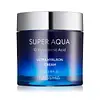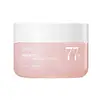What's inside
What's inside
 Key Ingredients
Key Ingredients

 Benefits
Benefits

 Concerns
Concerns

 Ingredients Side-by-side
Ingredients Side-by-side

Water
Skin ConditioningButylene Glycol
HumectantGlycerin
HumectantNiacinamide
SmoothingPhenyl Trimethicone
Skin Conditioning1,2-Hexanediol
Skin ConditioningCetyl Ethylhexanoate
EmollientPentaerythrityl Tetraethylhexanoate
EmollientPentylene Glycol
Skin ConditioningCetearyl Alcohol
EmollientButyrospermum Parkii Butter
Skin ConditioningPanthenol
Skin ConditioningRaffinose
Skin ConditioningAmmonium Acryloyldimethyltaurate/Vp Copolymer
Simmondsia Chinensis Seed Oil
EmollientDimethicone/Vinyl Dimethicone Crosspolymer
Skin ConditioningTromethamine
BufferingCarbomer
Emulsion StabilisingCetearyl Glucoside
EmulsifyingAcrylates/C10-30 Alkyl Acrylate Crosspolymer
Emulsion StabilisingXanthan Gum
EmulsifyingEthylhexylglycerin
Skin ConditioningCaprylyl Glycol
EmollientCitrus Aurantium Bergamia Fruit Oil
MaskingAdenosine
Skin ConditioningSodium Phytate
Lavandula Angustifolia Oil
MaskingCitrus Aurantium Dulcis Peel Oil
MaskingSilica
AbrasiveSodium Hyaluronate
HumectantHydrolyzed Hibiscus Esculentus Extract
Skin ConditioningLupinus Albus Seed Extract
Skin ConditioningMoringa Oleifera Seed Extract
Skin ConditioningTrehalose
HumectantGlyceryl Glucoside
HumectantPinus Sylvestris Leaf Oil
MaskingPropanediol
SolventHydrogenated Lecithin
EmulsifyingXylitylglucoside
HumectantCeramide NP
Skin ConditioningAnhydroxylitol
HumectantGlucose
HumectantSucrose Stearate
EmollientXylitol
HumectantHydroxypropyltrimonium Hyaluronate
Stearic Acid
CleansingPalmitic Acid
EmollientSucrose Palmitate
EmollientBenzyl Glycol
SolventHydrolyzed Glycosaminoglycans
HumectantCholesterol
EmollientMacadamia Ternifolia Seed Oil
EmollientOlea Europaea Fruit Oil
MaskingVitis Vinifera Seed Oil
EmollientSodium Hyaluronate Crosspolymer
HumectantHydrolyzed Hyaluronic Acid
HumectantGlyceryl Caprylate
EmollientGlycosphingolipids
EmollientSodium Acetylated Hyaluronate
HumectantActinidia Polygama Fruit Extract
Skin ConditioningHyaluronic Acid
HumectantHydrolyzed Sodium Hyaluronate
Skin ConditioningPotassium Hyaluronate
Skin ConditioningLimonene
PerfumingLinalool
PerfumingWater, Butylene Glycol, Glycerin, Niacinamide, Phenyl Trimethicone, 1,2-Hexanediol, Cetyl Ethylhexanoate, Pentaerythrityl Tetraethylhexanoate, Pentylene Glycol, Cetearyl Alcohol, Butyrospermum Parkii Butter, Panthenol, Raffinose, Ammonium Acryloyldimethyltaurate/Vp Copolymer, Simmondsia Chinensis Seed Oil, Dimethicone/Vinyl Dimethicone Crosspolymer, Tromethamine, Carbomer, Cetearyl Glucoside, Acrylates/C10-30 Alkyl Acrylate Crosspolymer, Xanthan Gum, Ethylhexylglycerin, Caprylyl Glycol, Citrus Aurantium Bergamia Fruit Oil, Adenosine, Sodium Phytate, Lavandula Angustifolia Oil, Citrus Aurantium Dulcis Peel Oil, Silica, Sodium Hyaluronate, Hydrolyzed Hibiscus Esculentus Extract, Lupinus Albus Seed Extract, Moringa Oleifera Seed Extract, Trehalose, Glyceryl Glucoside, Pinus Sylvestris Leaf Oil, Propanediol, Hydrogenated Lecithin, Xylitylglucoside, Ceramide NP, Anhydroxylitol, Glucose, Sucrose Stearate, Xylitol, Hydroxypropyltrimonium Hyaluronate, Stearic Acid, Palmitic Acid, Sucrose Palmitate, Benzyl Glycol, Hydrolyzed Glycosaminoglycans, Cholesterol, Macadamia Ternifolia Seed Oil, Olea Europaea Fruit Oil, Vitis Vinifera Seed Oil, Sodium Hyaluronate Crosspolymer, Hydrolyzed Hyaluronic Acid, Glyceryl Caprylate, Glycosphingolipids, Sodium Acetylated Hyaluronate, Actinidia Polygama Fruit Extract, Hyaluronic Acid, Hydrolyzed Sodium Hyaluronate, Potassium Hyaluronate, Limonene, Linalool
Prunus Persica Fruit Extract 77%
AbrasiveGlycerin
HumectantMethylpropanediol
SolventNiacinamide
SmoothingIsododecane
EmollientLactobacillus Ferment
Skin Conditioning1,2-Hexanediol
Skin ConditioningPropanediol
SolventPanthenol
Skin ConditioningPolyglyceryl-3 Methylglucose Distearate
EmulsifyingPolymethylsilsesquioxane
Hydrogenated Polydecene
EmollientJojoba Esters
EmollientCoptis Japonica Root Extract
Skin ConditioningPrunus Persica Flower Extract
MoisturisingSoluble Collagen
HumectantSodium Hyaluronate
HumectantVinyldimethicone
Ammonium Acryloyldimethyltaurate/Vp Copolymer
Water
Skin ConditioningDimethiconol
EmollientAcrylates/C10-30 Alkyl Acrylate Crosspolymer
Emulsion StabilisingTromethamine
BufferingButylene Glycol
HumectantAdenosine
Skin ConditioningDisodium EDTA
Cyanocobalamin
Skin ConditioningSaccharomyces Ferment Filtrate
HumectantGalactomyces Ferment Filtrate
HumectantBifida Ferment Lysate
Skin ConditioningCeramide NP
Skin ConditioningPectin
Emulsion StabilisingMaltodextrin
AbsorbentHydrolyzed Vegetable Protein
Skin ConditioningParfum
MaskingHydroxyacetophenone
AntioxidantEthylhexylglycerin
Skin ConditioningPrunus Persica Fruit Extract 77%, Glycerin, Methylpropanediol, Niacinamide, Isododecane, Lactobacillus Ferment, 1,2-Hexanediol, Propanediol, Panthenol, Polyglyceryl-3 Methylglucose Distearate, Polymethylsilsesquioxane, Hydrogenated Polydecene, Jojoba Esters, Coptis Japonica Root Extract, Prunus Persica Flower Extract, Soluble Collagen, Sodium Hyaluronate, Vinyldimethicone, Ammonium Acryloyldimethyltaurate/Vp Copolymer, Water, Dimethiconol, Acrylates/C10-30 Alkyl Acrylate Crosspolymer, Tromethamine, Butylene Glycol, Adenosine, Disodium EDTA, Cyanocobalamin, Saccharomyces Ferment Filtrate, Galactomyces Ferment Filtrate, Bifida Ferment Lysate, Ceramide NP, Pectin, Maltodextrin, Hydrolyzed Vegetable Protein, Parfum, Hydroxyacetophenone, Ethylhexylglycerin
 Reviews
Reviews

Ingredients Explained
These ingredients are found in both products.
Ingredients higher up in an ingredient list are typically present in a larger amount.
1,2-Hexanediol is a synthetic liquid and another multi-functional powerhouse.
It is a:
- Humectant, drawing moisture into the skin
- Emollient, helping to soften skin
- Solvent, dispersing and stabilizing formulas
- Preservative booster, enhancing the antimicrobial activity of other preservatives
Acrylates/C10-30 Alkyl Acrylate Crosspolymer is a synthetic polymer. It is used to thicken and improve the texture of products. Due to its properties, it can prevent water and oil ingredients from separating.
Adenosine is in every living organism. It is one of four components in nucleic acids that helps store our DNA.
Adenosine has many benefits when used. These benefits include hydrating the skin, smoothing skin, and reducing wrinkles. Once applied, adenosine increases collagen production. It also helps with improving firmness and tissue repair.
Studies have found adenosine may also help with wound healing.
In skincare products, Adenosine is usually derived from yeast.
Learn more about AdenosineAmmonium Acryloyldimethyltaurate/Vp Copolymer (let's call it AAVC for short) is a synthetically created polymer. It's used as a film-forming agent and used to thicken the consistency of products.
AAVC is able to increase the consistency and viscosity of products due to its large molecule size. It also prevents ingredients from separating.
Butylene Glycol (or BG) is used within cosmetic products for a few different reasons:
Overall, Butylene Glycol is a safe and well-rounded ingredient that works well with other ingredients.
Though this ingredient works well with most skin types, some people with sensitive skin may experience a reaction such as allergic rashes, closed comedones, or itchiness.
Learn more about Butylene GlycolCeramide NP is a type of ceramide and formally known as ceramide 3.
Ceramides are intercellular lipids naturally found in our skin that bonds dead skin cells together to create a barrier. They are known for their ability to hold water and thus are a great ingredient for dry skin.
Ceramides are an important building block for our skin barrier. A stronger barrier helps the skin look more firm and hydrated. By bolstering the skin ceramides act as a barrier against irritating ingredients. This can help with inflammation as well.
If you would like to eat ceramides, sweet potatoes contain a small amount.
Read more about other common types of ceramides here:
Ceramide AP
Ceramide EOP
Ethylhexylglycerin (we can't pronounce this either) is commonly used as a preservative and skin softener. It is derived from glyceryl.
You might see Ethylhexylglycerin often paired with other preservatives such as phenoxyethanol. Ethylhexylglycerin has been found to increase the effectiveness of these other preservatives.
Glycerin is already naturally found in your skin. It helps moisturize and protect your skin.
A study from 2016 found glycerin to be more effective as a humectant than AHAs and hyaluronic acid.
As a humectant, it helps the skin stay hydrated by pulling moisture to your skin. The low molecular weight of glycerin allows it to pull moisture into the deeper layers of your skin.
Hydrated skin improves your skin barrier; Your skin barrier helps protect against irritants and bacteria.
Glycerin has also been found to have antimicrobial and antiviral properties. Due to these properties, glycerin is often used in wound and burn treatments.
In cosmetics, glycerin is usually derived from plants such as soybean or palm. However, it can also be sourced from animals, such as tallow or animal fat.
This ingredient is organic, colorless, odorless, and non-toxic.
Glycerin is the name for this ingredient in American English. British English uses Glycerol/Glycerine.
Learn more about GlycerinNiacinamide is a multitasking form of vitamin B3 that strengthens the skin barrier, reduces pores and dark spots, regulates oil, and improves signs of aging.
And the best part? It's gentle and well-tolerated by most skin types, including sensitive and reactive skin.
You might have heard of "niacin flush", or the reddening of skin that causes itchiness. Niacinamide has not been found to cause this.
In very rare cases, some individuals may not be able to tolerate niacinamide at all or experience an allergic reaction to it.
If you are experiencing flaking, irritation, and dryness with this ingredient, be sure to double check all your products as this ingredient can be found in all categories of skincare.
When incorporating niacinamide into your routine, look out for concentration amounts. Typically, 5% niacinamide provides benefits such as fading dark spots. However, if you have sensitive skin, it is better to begin with a smaller concentration.
When you apply niacinamide to your skin, your body converts it into nicotinamide adenine dinucleotide (NAD). NAD is an essential coenzyme that is already found in your cells as "fuel" and powers countless biological processes.
In your skin, NAD helps repair cell damage, produce new healthy cells, support collagen production, strengthen the skin barrier, and fight environmental stressors (like UV and pollution).
Our natural NAD levels start to decline with age, leading to slower skin repair, visible aging, and a weaker skin barrier. By providing your skin niacinamide, you're recharging your skin's NAD levels. This leads to stronger, healthier, and younger looking skin.
Another name for vitamin B3 is nicotinamide. This vitamin is water-soluble and our bodies don't store it. We obtain Vitamin B3 from either food or skincare. Meat, fish, wheat, yeast, and leafy greens contain vitamin B3.
The type of niacinamide used in skincare is synthetically created.
Learn more about NiacinamidePanthenol is a common ingredient that helps hydrate and soothe the skin. It is found naturally in our skin and hair.
There are two forms of panthenol: D and L.
D-panthenol is also known as dexpanthenol. Most cosmetics use dexpanthenol or a mixture of D and L-panthenol.
Panthenol is famous due to its ability to go deeper into the skin's layers. Using this ingredient has numerous pros (and no cons):
Like hyaluronic acid, panthenol is a humectant. Humectants are able to bind and hold large amounts of water to keep skin hydrated.
This ingredient works well for wound healing. It works by increasing tissue in the wound and helps close open wounds.
Once oxidized, panthenol converts to pantothenic acid. Panthothenic acid is found in all living cells.
This ingredient is also referred to as pro-vitamin B5.
Learn more about PanthenolPropanediol is an all-star ingredient. It softens, hydrates, and smooths the skin.
It’s often used to:
Propanediol is not likely to cause sensitivity and considered safe to use. It is derived from corn or petroleum with a clear color and no scent.
Learn more about PropanediolSodium Hyaluronate is hyaluronic acid's salt form. It is commonly derived from the sodium salt of hyaluronic acid.
Like hyaluronic acid, it is great at holding water and acts as a humectant. This makes it a great skin hydrating ingredient.
Sodium Hyaluronate is naturally occurring in our bodies and is mostly found in eye fluid and joints.
These are some other common types of Hyaluronic Acid:
Learn more about Sodium HyaluronateTromethamine helps balance the pH and improve the texture of a product. It is synthetically created.
As an emulsifier, Tromethamine prevents oil and water ingredients from separating. This helps stabilize the product and elongate a product's shelf life. Tromethamine also makes a product thicker.
Tromethamine helps balance the pH level of a product. Normal pH level of skin is slightly acidic (~4.75-5.5). The acidity of our skin is maintained by our glands and skin biome. Being slightly acidic allows our skin to create an "acid mantle". This acid mantle is a thin barrier that protects our skin from bacteria and contaminants.
Oral Tromethanmine is an anti-inflammatory drug but plays the role of masking, adding fragrance, and/or balancing pH in skincare.
1,3-Propanediol, 2-amino-2-(hydroxymethyl)-
Learn more about TromethamineWater. It's the most common cosmetic ingredient of all. You'll usually see it at the top of ingredient lists, meaning that it makes up the largest part of the product.
So why is it so popular? Water most often acts as a solvent - this means that it helps dissolve other ingredients into the formulation.
You'll also recognize water as that liquid we all need to stay alive. If you see this, drink a glass of water. Stay hydrated!
Learn more about Water